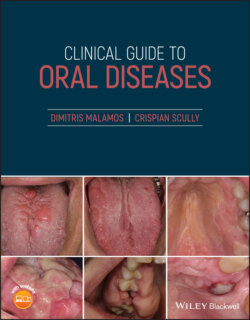Читать книгу Clinical Guide to Oral Diseases - Crispian Scully - Страница 14
1 Bleeding
ОглавлениеBleeding in the mouth may be a sign of various conditions related to the structure of blood vessels, the number or function of white blood cells and especially platelets, the deficiency or dysfunction of clotting factors or even interaction of various drugs. Some of these bleeding disorders appear at a very young age; some are also found among close relatives (inherited) while others are noticed later with a negative family history (acquired). The severity of the bleeding ranges from minor hemorrhages from gingivae and other parts of the oral mucosa with the formation of petechiae or ecchymosis (Figure 1.0), to extensive bleeding in other parts of the body, causing severe blood loss, even jeopardizing the patient's life.
The more important causes of oral bleeding are seen in Table 1.
Figure 1.0 Tongue hematoma in a woman with seizures.
Table 1 Conditions related to oral bleeding.
| Common and important conditions |
| Local conditionsGingivitis/periodontitisGranuloma pyogenic/giant cellJaw fractureTraumaTumors invading blood vesselsSystemic conditionsCongenitalHemophilia A or BVon Willebrand's diseaseOther factor deficienciesGlanzman thrombastheniaAcquiredrelated to coagulationLiver diseaseVit. K deficiency, warfarin drug useDisseminated intravascular coagulationrelated to thrombocytopeniaIdiopathicDrug‐inducedCollagen vascular diseaseSarcoidosisHemolytic anemiaLeukemiaMyelomaWaldestmomrelated to platelet dysregulationAlcoholismChronic renal failureDrugsLiver diseaserelated to vascular disordersAngina bullosa hemorrhagicaAngiomasEhrler‐Danlos syndromeHereditary hemorrhagic telangiectasiaInfections from Ebola, HIV, HSV; EBV, RubellaMarfan syndromePurpuraScurvyrelated to fibrinolysisAmyloidosisStreptokinase treatment |
